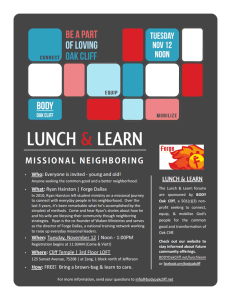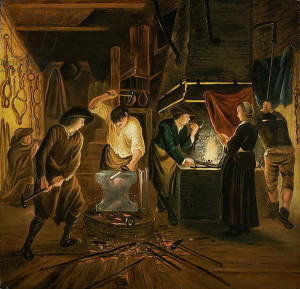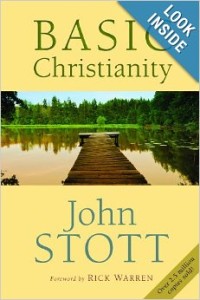Pastoral Backstory 11.14.13

(What is the Backstory and why?)
November 14th, 2013
The effort to become faithfully present to his neighborhood began with an apology.
His neighbor was a burly, Irish Catholic, several years his senior. Despite living across the street for nearly two years, Ryan knew only his first name. So with part embarrassment, part trepidation Ryan approached him while he edged his lawn, donned reclusively in headphones and sunglasses. Seeing Ryan approach did not elicit the sort of neighborly greeting you might expect. Instead Ryan was “received” with an almost irritated “yeah?” Surely with something of a lump in his throat Ryan re-introduced himself by apologizing for not trying to get to know him and his family, and then also confessed how that his indifference really indicated an implicit belief that Ryan didn’t think this man could add anything to his own life.
Talk about a conversation you don’t expect to hear among neighbors these days.
His neighbor, as you would expect, returned the comment with a befuddled look and then offered an awkward “thanks.” Conversation over. Ryan turned back to his home. The next day Ryan got a text from his neighbor who expanded on his tepid gratitude, and then asked if he wanted to have breakfast the next morning.
Three and a half years later, Ryan, his neighbor, and around 8 others from the neighborhood eat breakfast at least once a month and share their lives.

Ryan Hairston works for a ministry called Forge which seeks to train individuals, families, and churches in how to live in a way more consonant with true neighborliness. I had the privilege this week of hearing his story and his vision for “neighboring” (as they’ve come to call it) during a seminar with pastors and other para-church leadership in S. Dallas.
Forge recognizes how local churches can unintentionally diminish parishioners’ interest and time for neighboring (or “living missionally,” the current buzzword) by simply dominating their schedules and consolidating all efforts to be present to the world through the direct coordination of the church. So Forge helps believers imagine how they can become a blessing unto those they’re most proximate to. For they recognize that a demonstration of neighborliness is often what sets up the ability to proclaim Him who taught both who our neighbor is and what it means to be neighborly–just as we argued last Sunday.
At Tuesday’s seminar, Ryan shared several anecdotes of how simple efforts to know and serve his neighbors enriched the community, and moreover, elicited the sort of curiosity as to why he and his family had taken such an interest in the whole neighborhood’s life. The practice of faith provoked an interest in the beliefs that compelled it–another truth we learned from Peter’s encouragements last week.
Perhaps the most compelling lesson he’s learned from neighboring so far is that one of the greatest ways to be a neighbor is to ask for help from a neighbor. Premised on the biblical notion that all are made in the image of God and therefore have something to offer that “adds value” to a community, Ryan and others like him have learned how making oneself vulnerable by acknowledging a need does as much to build community as meeting a need in the community. So he extolled all who were present this week: if a neighbor is ever headed to the store and asks if you need something, you always say, “yes.”
Each of our sermons on the vision for faithful presence has labored to provide real and practicable ways to apply the concept. Ryan and Forge offer us a way of living in our neighborhoods that, while fairly unfamiliar in suburbia apart from the occasional cookout, opens up innumerable applications of presence to one of our most immediate worlds. Where might the courageous and contrite apologies begin in your neighborhood? And then, more importantly, what small efforts might you take to bless those in your neck of the woods? There begins the application of our last two sermons on presence to our world, the last leg of our series.

We’ll conclude the series this Sunday by in one sense returning to where we started: with prayer. Our series began with listening to Jesus’ prayer for the church’s faithful presence. It will end (and yet begin again) with Jesus’ teaching on prayer to the church-prayer that means to refashion us from a distracted, fragmented people into those who are fully and faithfully present. Sit with Matthew 6:7-15 and hear Sunday how this prayer no script, but something else entirely.
*****
Community quick hits:
A congregational meeting has been called for December 1st during our 2nd hour for a vote on elder candidates and the pastoral call. Refreshments will be served. All are encouraged to come.
Pending the outcome of the vote on December 1, CtK will have a service of Particularization on December 15th during which elders and pastor will be installed, and both leadership and congregation given their respective charges from officers of our presbytery. Immediately following the service we’ll celebrate with a catered reception in the Fellowship Hall. Mark this milestone in the young life of CtK.
Those interested in coming for membership in CtK should save the date, January 10-11 (Fri-Sat) for our next membership class. A time to dig deeper into what membership means, how we plan to live out the vision of CtK. It’s also a time to ask questions about faith, community, and our leadership.
 We made mention last Sunday of an upcoming seminar on how to prepare in advance a “defense of the reason for the hope that is in you.” Here’s a few more details. Prof Mike Rasmussen will return to lead the seminar Saturday, February 1st, from 8:30-noon at FBC. (Yes we’ll have good coffee brewing). Copies of the book for the seminar, John Stott’s Basic Christianity, are on order and will be on sale for $5. Save the date and get to reading.
We made mention last Sunday of an upcoming seminar on how to prepare in advance a “defense of the reason for the hope that is in you.” Here’s a few more details. Prof Mike Rasmussen will return to lead the seminar Saturday, February 1st, from 8:30-noon at FBC. (Yes we’ll have good coffee brewing). Copies of the book for the seminar, John Stott’s Basic Christianity, are on order and will be on sale for $5. Save the date and get to reading.
*****
And would you pray:
- for Phil and Sheila Steven’s daughter, Sara, and her family in Indiana
- for the weary, the disillusioned, the shocked, the confused, and the afflicted among us and on our minds
- for those suffering the ravages of the Philippine typhoon and for the relief efforts now underway–including the Mission to the World (MTW) efforts to which CtK made contribution this week
- for Justin and Amanda Isaac as they welcome little Aliah Victoria into the world (born November 5th)
See you Sunday at 9:30,
Patrick
